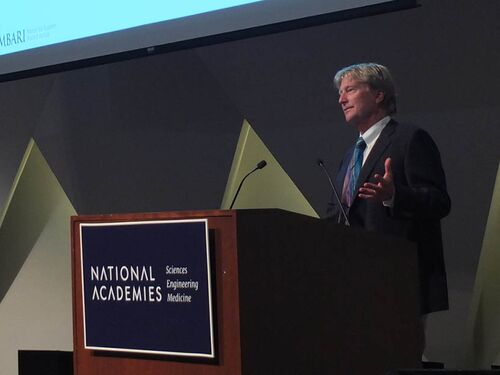A New Era for Oceanography: 26th Annual Roger Revelle Commemorative Lecture Examines Ocean Exploration in the Age of Intelligent Robots and a Changing Climate
Feature Story
By Hannah Fuller
Last update May 9, 2025
Event photos ©Bruce Guthrie
The ocean is vast, deep, and often inaccessible to humans. But in recent decades, robots and other technologies have started to give researchers a view of life thousands of meters below the ocean’s surface, unlocking new knowledge about how the ocean circulates carbon and nutrients, how ecosystems thrive in the deep ocean, and what economic opportunities may lie in this hidden world.
An examination of these technological innovations and the surprising insights they are yielding, especially in a rapidly warming world, was the focus of this year’s Roger Revelle Commemorative Lecture, Ocean Exploration in the Age of Intelligent Robots and a Changing Climate, which was delivered by Christopher Scholin, president and chief executive officer of the Monterey Bay Aquarium Research Institute (MBARI).
“Robots and sensors have changed the way we can interact with the environment,” Scholin explained. Developing new technologies for exploring the sea is a “team sport,” he said, sharing many examples that showcase how biology, engineering, communications, and classic trial and error come together to create new technologies. By combining the different sensing technologies on floats and deploying them around the globe, “we are beginning to paint a fuller picture of this massive part of our planet that has so much left to explore.”
In a warming climate, data collection is more important than ever as Earth’s systems respond and ecosystems change. “We now know that the Southern Ocean — one of the most inaccessible and difficult places to work — plays a major role in ocean-atmosphere carbon cycling and global climate modulation,” said Scholin. “We’re in a race to learn more about the ocean, as it undergoes rapid change. It’s nearly impossible to get a baseline. A sustained commitment to technology development is integral to competing in that race.”
Christopher A. Scholin (photo courtesy MBARI)Although technology allows for the collection of more types of higher-quality information from more sensors, researchers are now facing a “data deluge,” as Scholin puts it. Machine learning can be an immense time-saving solution to sort through and find patterns within data, which can then be analyzed and made sense of by scientists, he said.
New technologies are also enabling researchers to learn more about diverse life in the deepest ocean depths. “Throughout history, we have approached ocean exploration and observation through a decidedly human sensory perspective. There is still much to learn,” said Scholin. “Ocean-dwelling animals experience their environment in many ways we humans have not yet learned to interpret or fully comprehend, such as their perception of sound, electromagnetic fields, and chemosensory abilities.”
Scientists at MBARI use the Video Annotation and Reference System (VARS), where an expert can tag and annotate videos with the creatures that they observe. The volume of video data continues to grow as more cameras with higher resolution are added. But as VARS is now trained on 900,000 annotations by scientists, it is getting increasingly better at identifying species as they are captured in video, giving researchers more time to analyze the data itself. In addition, the public can also help researchers with FathomVerse, a game that challenges the player to help identify species and provides additional training for machine learning along the way.
“Much of the technological revolution that has been brought to bear on ocean exploration and observation was primarily driven by a variety of industries for purposes that often had nothing to do with marine science,” said Scholin. Advancements in microelectronics, biopharma, aerospace, manufacturing, material and computer science, and other disciplines, as well as social media, have dramatically transformed our ability to access the sea, reveal its mysteries, and share the findings with a global audience. “This cycle is accelerating. Every time we return to the ocean with new technologies in hand, we learn something new and grow to appreciate the connection between societal well-being and the health of the sea.”
Watch a recording of Scholin’s full lecture and read his accompanying essay online.
Related Resources




